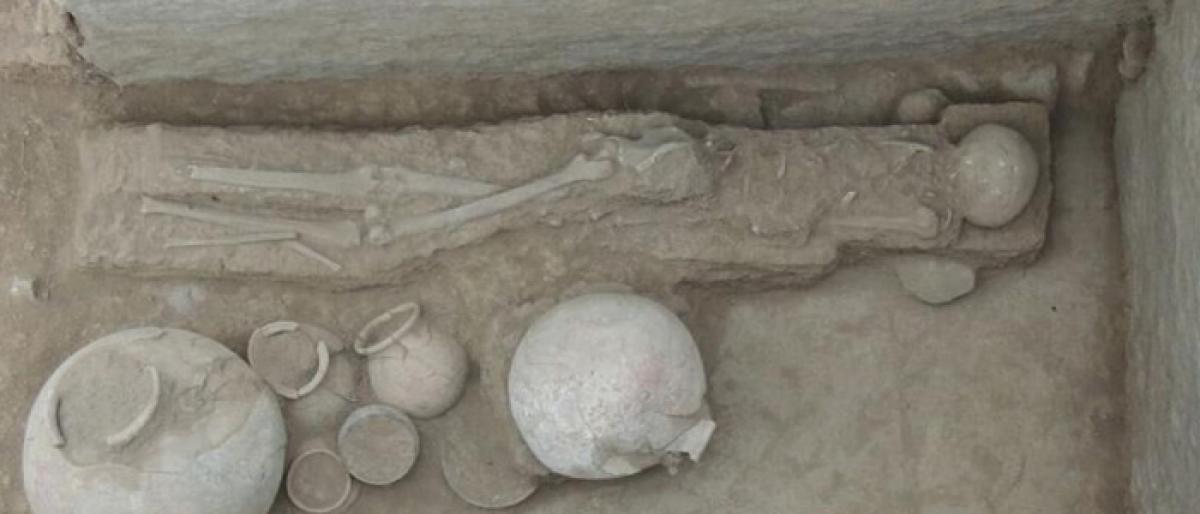Live
- KTR Appoints Constituency Coordinators for Warangal Parliament Elections
- Supreme Court To Review Arvind Kejriwal's Plea Against Arrest In Delhi Liquor Policy Case
- All set for filing of nominations for general elections in AP and Telangana from April 18
- Businessman from Gujarat donates Rs. 200 crore, to take updates life of Monk
- Back RaGa, if you wish to make gold affordable: Jagga
- Petrol and diesel prices today stable in Hyderabad, Delhi, Chennai and Mumbai on 16 April
- Ease election code & allow telecast of celestial wedding at Bhadradri’
- Visakha court likely to announce verdict in head tonsure case today
- Poll fever yet to grip Chevella
- Bapatla: ‘Extend cooperation for smooth conduct of polls’
Just In

The hidden history which provides insights into human origins spread around elephant shaped Gajagirigutta hillock has now begun to unravel. The undying spirit of a local history buff R Ratnakar Reddy and the just-concluded excavations carried by a team led by Prof KP Rao of University of Hyderabad (UoH) throw fresh evidences that, by 1000 BC, the region had a possible diasporic community connectio
Janagaon: The hidden history which provides insights into human origins spread around elephant shaped Gajagirigutta hillock has now begun to unravel. The undying spirit of a local history buff R Ratnakar Reddy and the just-concluded excavations carried by a team led by Prof KP Rao of University of Hyderabad (UoH) throw fresh evidences that, by 1000 BC, the region had a possible diasporic community connection with Sri Lanka.
It may be noted here that the terrain which houses a series of hillocks – Bodagutta, Elukalabodu, Thokala Ene etc. scattered around Gajagirigutta near Konney village under Bachhannapet mandal in Janagaon district – crusted with rich remnants of bygone era has now become a potential hotspot for archaeological investigations.
The region has pit burials, cist burials, dolmens and menhirs indicating human habitation spanned through Neolithic, Megalithic and early historic periods. According to the local lore, early humans lived in the surroundings of Gajagirigutta, terming it as Rakasipatnam.
Janagoan-based history enthusiast who extensively collected remnants of yesteryears such as beads, earthen pots, rock tools etc. R Ratnakar Reddy said, “The remnants suggest that life existed here since the times of early man. The soil texture which is soft indicates that people lived here practiced agriculture.” The remnants also suggest Buddhism also embellished in the region before they left for Sri Lanka and Burma, he opined, referring to the Dharma Chakra stamp/seal made of terracotta.
On the other hand, the UoH team which wound up its 45-day excavation in the region has collected quite a few remnants – pottery, skeletal remains of animals, iron objects, seashells, a copper ring etc.
Speaking to The Hans India, Prof KP Rao, the team leader, said, “The excavations carried out in two trenches have yielded good results as we were able to find quite a few items such as turquoise bead and seashell beads used as beads. Turquoise beads are found only in Sri Lanka. This suggests that there was a possibility of people commuting between the region and Sri Lanka.” After radiocarbon dating only, the age of objects would be determined, he added.
Two megalithic burials were also found during the excavation. Both of these burials contain skeletal remains of humans, he said, stating that analysis was yet to be done on these findings.
Eleanor Kingwell-Banham, a research associate in the eight-decade-old UCL Institute of Archaeology, one of the largest centres for archaeology, cultural heritage and museum studies in Britain, also visited the excavation site and collected micro-botanical remains such as pollen, phytolith, charred grains etc. Her study is to find out agricultural practices and the dietary habits during the proto-historic period.

© 2024 Hyderabad Media House Limited/The Hans India. All rights reserved. Powered by hocalwire.com







